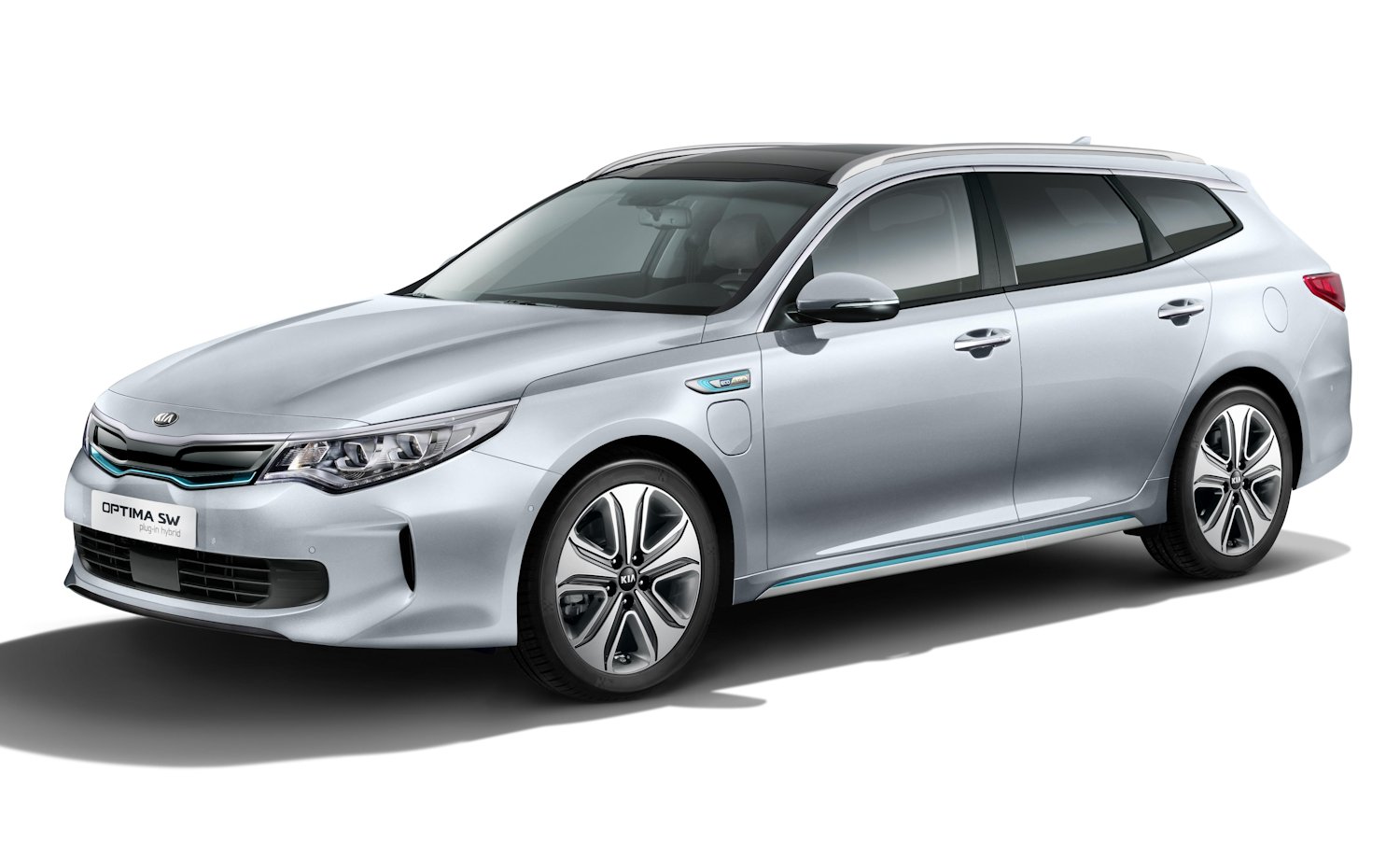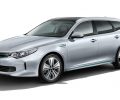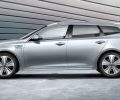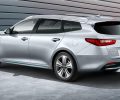
- New Plug-in Hybrid model on sale across Europe from Q3 2017
- High-capacity batteries and 2.0-litre GDI engine
- Versatile 440-litre cargo space with 40:20:40 split-fold rear seats
- Latest infotainment system features Android Auto™ and Apple CarPlay™
- Advanced energy-saving measures maximise EV range and efficiency
- High-strength bodyshell and active safety assistance technologies
- Smooth ride and responsive handling
The new Optima Sportswagon Plug-in Hybrid is unveiled today at the Geneva International Motor Show, and will go on sale across Europe from Q3 2017. The Optima Sportswagon Plug-in Hybrid is the latest model to join Kia’s growing line up of innovative low-emissions vehicles.
The new derivative combines the versatility of the conventional Optima Sportswagon with the high-efficiency powertrain found in the Optima Plug-in Hybrid sedan, introduced in the third quarter of 2016. The new model provides buyers with 440 litres (VDA, with rear seats in upright position) of cargo space – 133 litres more than the Optima Plug-in Hybrid sedan.
With Kia development teams targeting a pure electric range of over 60 kilometres (combined, New European Driving Cycle) before its 2.0-litre GDI (gasoline direct injection) engine kicks in, the new model could emit just 34 g/km CO2 (combined, NEDC), ensuring low running costs and maximum practicality for private and fleet buyers. Final electric range and CO2 emissions figures will be published closer to the car’s on-sale date.
Michael Cole, Chief Operating Officer, Kia Motors Europe, commented: “We expanded the Optima range in the third quarter of 2016 with new Optima Sportswagon and Plug-in Hybrid sedan versions – each respectively accounting for 62 per cent and 13 per cent of Optima sales. With a clear demand for both of these models, the Sportswagon Plug-in Hybrid combines the benefits of the two and completes the Optima line-up.
“The introduction of eco-friendly vehicles such as the Optima Sportswagon Plug-in Hybrid will ensure Kia remains on course to achieve its mission of improving average fleet fuel efficiency by 25 per cent by 2020, compared to 2014 levels.”
The Optima Sportswagon Plug-in Hybrid is one of two low-emissions vehicles launched by Kia at the Geneva International Motor Show, together with the new Niro Plug-in Hybrid compact crossover.
Targeted 60-kilometre plus pure-electric range, 34 g/km CO2 emissions, and efficient packaging
The Optima Sportswagon Plug-in Hybrid is powered by a 11.26 kWh lithium-polymer battery pack paired with a 50 kW electric motor, providing a provisional pure-electric range of more than 60km (38 miles) at speeds of up to 120 kph. The Optima Sportswagon Plug-in Hybrid will be among the leaders in the D-segment for pure-electric range capability.
The powertrain employs Kia’s efficient 2.0-litre ‘Nu’ four-cylinder GDI engine, generating156 ps and 189 Nm. Coupled with the electric motor, it allows the car to operate in charge-sustaining mode once the battery runs out of charge. The powertrain’s total power output is 205 ps at 6,000 rpm, with a high torque output of 375 Nm (276 lb ft) from just 2,330 rpm, providing acceleration from 0-to-100 kph in 9.7 seconds. Power is applied to the road through a six-speed automatic gearbox, with the transmission-mounted 50 kW electric motor replacing the traditional torque converter.
The Optima Sportswagon Plug-in Hybrid’s next-generation battery system features a 11.26 kWh lithium-ion polymer battery pack, offering a blend of highly-efficient electric and internal combustion power, and a consistently high level of performance. The efficient packaging of the battery pack – which is located beneath the boot floor – allows the Optima Sportswagon Plug-in Hybrid to give buyers a generous 440-litre (VDA, seats in upright position) cargo capacity, which becomes 1,574-litres (VDA) with the rear seats folded flat.
Kia development teams have targeted carbon dioxide emissions of 34 g/km (combined, NEDC), and fuel economy of 1.5 litres per 100 km (combined, NEDC). Final figures will be published closer to the car’s on-sale date.
Maximum range from fuel-saving and energy harvesting technologies
The Optima Sportswagon Plug-in Hybrid is equipped with a series of innovations to enhance battery efficiency. These includetwo key technologies to save and regenerate battery power – regenerative braking and an advanced heating, ventilation and air conditioning (HVAC) system. Kia’s advanced HVAC system, employs a smart air intake system which provides ventilation and heating to the driver area only, shutting off ventilation to other areas of the car to reduce the load on the battery and increase range.Kia’s regenerative braking system allows the car to harvest kinetic energy while coasting or braking.
Design and technology
The Optima Sportswagon Plug-in Hybrid shares common design features with the Plug-in Hybrid sedan, with reprofiled, more aerodynamically-efficient bumpers, side skirts and wheels, chrome brightwork, and ‘ECO plug-in’ badging.
Inside, a new driver instrument cluster displays key information about the powertrain – such as the battery’s state of charge and feedback on driving efficiency.The car is equipped with Kia’s latest audio-visual navigation (AVN) technology, with an 8.0-inch touchscreen infotainment system displaying current EV range and the location of nearby charging stations. The AVN system is also available with Android Auto™ and Apple CarPlay™, as well as Kia Connected Services powered by TomTomTM, providing live traffic updates, speed camera alerts and weather forecasts. The Optima Sportswagon Plug-in Hybrid is available with Kia’s wireless smartphone charger, letting users charge mobile devices on the move.
The Optima Sportswagon Plug-in Hybrid is available with a suite of active safety technologies designed to avoid or mitigate the effects of a collision. Kia’s Vehicle Stability Management (VSM) is fitted as standard, ensuring stability under braking and cornering by controlling the car’s Electronic Stability Control (ESC) and electric motor-driven power steering if it detects a loss of traction. Other optional active hazard-avoidance technologies include Advanced Smart Cruise Control (ASCC), Lane Keeping Assist System (LKAS) and Autonomous Emergency Braking (AEB)*.
2017 Kia Optima Sportswagon Plug-in Hybrid on-sale from Q3 2017
The new Kia Optima Sportswagon Plug-in Hybrid will go on sale across Europe in Q3 2017 and is manufactured for European markets at Kia’s plant in Hwasung, Korea. The car is sold as standard with Kia’s unique 7-Year, 100,000 m warranty, which also covers the battery pack.
*The Autonomous Emergency Braking System (AEBS) is an assistance system and does not relieve the driver from his/her responsibility to safely operate the vehicle at any time. The driver still has to adapt his/her driving behaviour to his/her personal driving capabilities, to the legal requirements and to the overall road and traffic conditions. AEBS is not designed to drive the vehicle autonomously. For further information, please refer to the owner’s manual.
ALL NEW KIA OPTIMA SPORTSWAGON PLUG-IN HYBRID – TECHNICAL SPECIFICATIONS (EUROPE)
Body and chassis
Four-door, five-seater tourer, with all-steel unitary construction bodyshell. Petrol four-cylinder engine and parallel hybrid system driving the front wheels via six-speed automatic transmission.
Engines
2.0-litre / 156 ps GDI
Type Four-cylinder in-line, naturally aspirated
Capacity 2.0-litres, 1,999 cc
Max power 156 ps (115 kW) @ 6,000 rpm
Max torque 189 Nm (140 lb ft) @ 5,000 rpm
Valves 16 (four per cylinder)
Fuel system Gasoline direct injection
Emissions class Euro Stage 6b
Battery and electric motor
Battery type Lithium-polymer
Voltage 360 V
Energy 11.26kWh
Max power (motor) 67 ps (50 kW) @ 2,330-3,300 rpm
Max torque 205 Nm (151 lb ft) @ 0~2,330 rpm
Combined hybrid system
Total power 205 ps (151 kW) @ 6,000 rpm
Total torque 375 Nm (276 lb ft) @ 2,330 rpm
Transmissions
Six-speed automatic transmission
Gear ratios
1 4.639
2 2.826
3 1.841
4 1.386
5 1.000
6 0.772
Reverse 3.385
Final Drive 1 3.510
Suspension and damping
Front Fully-independent by subframe-mounted MacPherson struts, coil springs and gas-filled shock absorbers, with anti-roll stabiliser bar
Rear Fully-independent by subframe-mounted double wishbones, coil springs and gas-filled shock absorbers, with anti-roll stabiliser bar
Steering
Gearing 14.3:1
Turns, lock-to-lock 2.78
Turning circle 5.45 metres
Type Electric Column-mounted motor-driven power steering
Brakes
Front 300 mm ventilated discs
Rear 300 mm solid discs
Wheels and tyres
Standard Alloy 17-inch, 215/55 R17 tyres
Spare Tyre mobility kit
Dimensions (mm)
Exterior
Overall length 4,855 Overall width* 1,860
Overall height 1,465 (1,470 w/ roof rack) Wheelbase 2,805
Front track** 1,602 Rear track** 1,609
Front overhang 965 Rear overhang 1,085
Ground clearance 135
*excluding door mirrors
**on 17-inch wheels
Interior
1st row 2nd row
Head room 1,020 985
Leg room 1,155 905
Shoulder room 1,475 1,432
Hip room 1,423 1,422
Capacities
Fuel tank 55 litres
Luggage (VDA) 440 litres
Weights (kg)
Curb weight 1,740
Tow capacity, braked 1,500
Performance
Top speed (kph) 192
0-100 kph (secs) 9.7
Economy (litres / 100 km, NEDC)*
Combined 1.5 (Development Target)
CO2, combined (g/km) 34 (Development Target)
*on 17-inch wheels
MARCH 2017




